- Home
- Resources
- Work samples
- Samples
- Water in the world - ABOVE
Humanities and Social Sciences
Year 7
Above satisfactory
Data analysis: Water in the world
 1
Learning Area
1
Learning Area
Articulates the overall connection between water, people, places and environments 2 Subject - Geography
Articulates the overall connection between water, people, places and environments 3 Learning Area
Explains a connection between people’s use of water and its impact on the environment 4 Subject - Geography
Explains a connection between people’s use of water and its impact on the environment 5 Learning Area
Predicts a geographical outcome using a conceptual argument 6 Subject - Geography
Predicts a geographical outcome using a conceptual argument
-
Annotations
-
1
Learning Area
Articulates the overall connection between water, people, places and environments -
2
Subject - Geography
Articulates the overall connection between water, people, places and environments -
3
Learning Area
Explains a connection between people’s use of water and its impact on the environment -
4
Subject - Geography
Explains a connection between people’s use of water and its impact on the environment -
5
Learning Area
Predicts a geographical outcome using a conceptual argument -
6
Subject - Geography
Predicts a geographical outcome using a conceptual argument
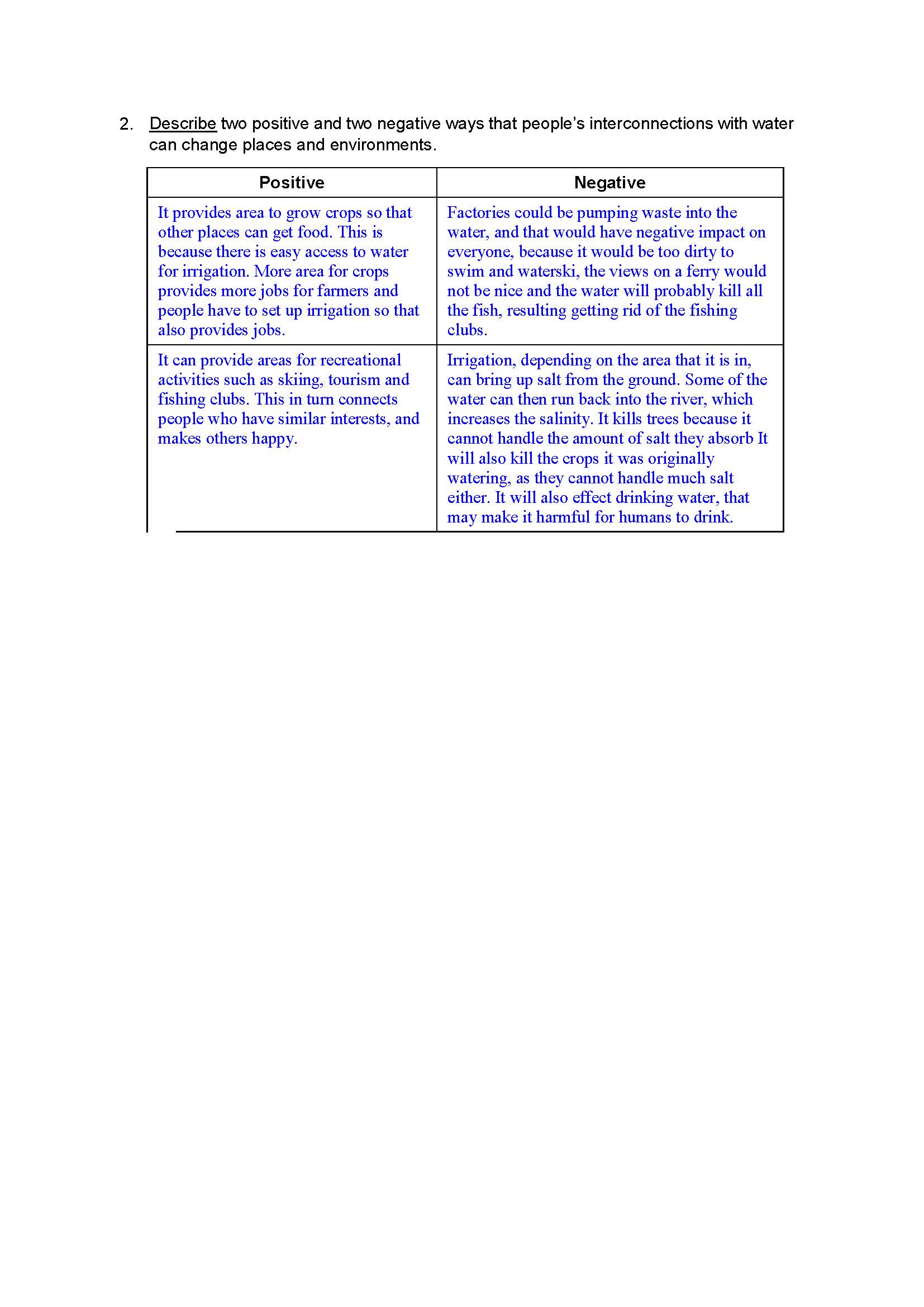 1
Learning Area
1
Learning Area
Provides a comprehensive description of how interconnections change places and environments 2 Subject - Geography
Provides a comprehensive description of how interconnections change places and environments 3 Learning Area
Uses relevant geographical terminology in an appropriate context 4 Subject - Geography
Uses relevant geographical terminology in an appropriate context 5 Learning Area
Draws conclusions using multiple connections from the diagram 6 Subject - Geography
Draws conclusions using multiple connections from the diagram 7 Learning Area
Describes in detail the interconnections between people’s actions and the environment 8 Subject - Geography
Describes in detail the interconnections between people’s actions and the environment
-
Annotations
-
1
Learning Area
Provides a comprehensive description of how interconnections change places and environments -
2
Subject - Geography
Provides a comprehensive description of how interconnections change places and environments -
3
Learning Area
Uses relevant geographical terminology in an appropriate context -
4
Subject - Geography
Uses relevant geographical terminology in an appropriate context -
5
Learning Area
Draws conclusions using multiple connections from the diagram -
6
Subject - Geography
Draws conclusions using multiple connections from the diagram -
7
Learning Area
Describes in detail the interconnections between people’s actions and the environment -
8
Subject - Geography
Describes in detail the interconnections between people’s actions and the environment
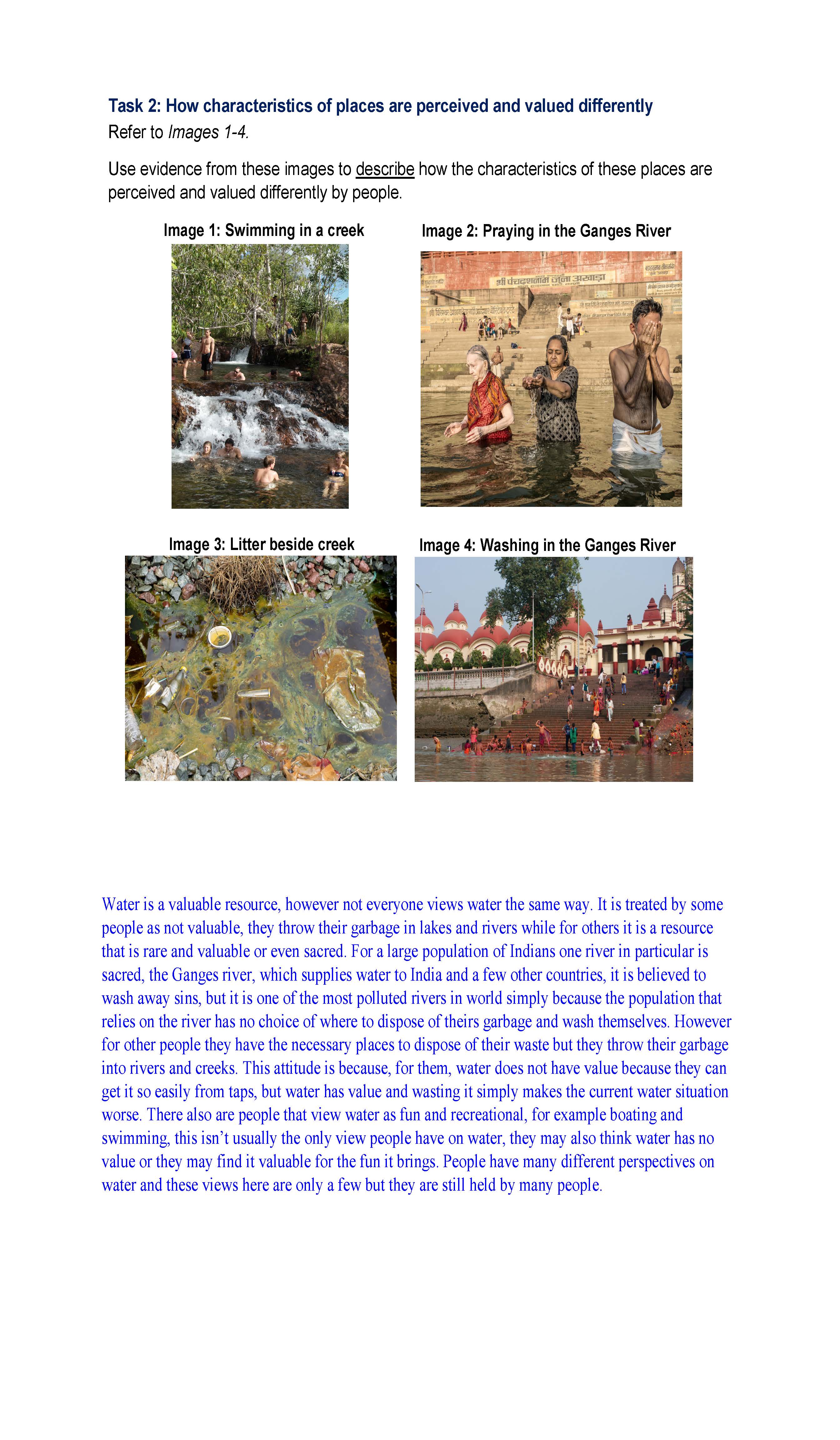 1
Learning Area
1
Learning Area
Presents an argument about a geographical phenomenon 2 Subject - Geography
Presents an argument about a geographical phenomenon 3 Learning Area
Describes a reason why people may perceive and value water differently 4 Subject - Geography
Describes a reason why people may perceive and value water differently 5 Learning Area
Explains the challenges associated with multiple uses of a single body of water 6 Subject - Geography
Explains the challenges associated with multiple uses of a single body of water 7 Learning Area
Proposes an explanation for negative use of water 8 Subject - Geography
Proposes an explanation for negative use of water 9 Learning Area
Synthesises evidence from multiple sources 10 Subject - Geography
Synthesises evidence from multiple sources 11 Learning Area
Draws a conclusion about how people view water differently 12 Subject - Geography
Draws a conclusion about how people view water differently
-
Annotations
-
1
Learning Area
Presents an argument about a geographical phenomenon -
2
Subject - Geography
Presents an argument about a geographical phenomenon -
3
Learning Area
Describes a reason why people may perceive and value water differently -
4
Subject - Geography
Describes a reason why people may perceive and value water differently -
5
Learning Area
Explains the challenges associated with multiple uses of a single body of water -
6
Subject - Geography
Explains the challenges associated with multiple uses of a single body of water -
7
Learning Area
Proposes an explanation for negative use of water -
8
Subject - Geography
Proposes an explanation for negative use of water -
9
Learning Area
Synthesises evidence from multiple sources -
10
Subject - Geography
Synthesises evidence from multiple sources -
11
Learning Area
Draws a conclusion about how people view water differently -
12
Subject - Geography
Draws a conclusion about how people view water differently
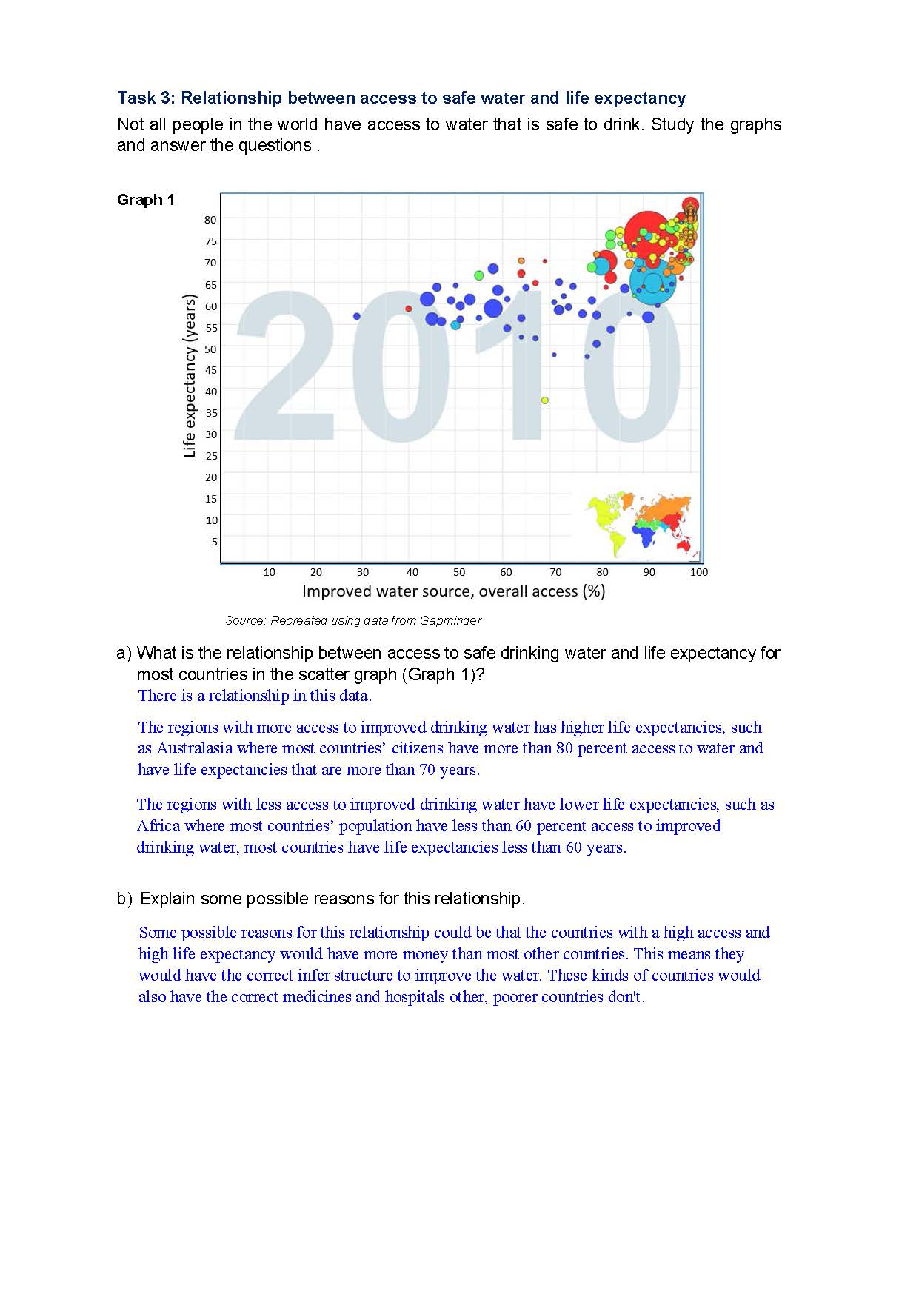 1
Learning Area
1
Learning Area
Describes accurately a geographic trend, citing specific data from the graph 2 Subject - Geography
Describes accurately a geographic trend, citing specific data from the graph 3 Learning Area
Identifies relationships between variables 4 Subject - Geography
Identifies relationships between variables 5 Learning Area
Uses relevant geographical terminology 6 Subject - Geography
Uses relevant geographical terminology 7 Learning Area
Synthesises data to draw a detailed conclusion 8 Subject - Geography
Synthesises data to draw a detailed conclusion 9 Learning Area
Explains how access to safe drinking water is connected to life expectancy, citing examples from the graph 10 Subject - Geography
Explains how access to safe drinking water is connected to life expectancy, citing examples from the graph
-
Annotations
-
1
Learning Area
Describes accurately a geographic trend, citing specific data from the graph -
2
Subject - Geography
Describes accurately a geographic trend, citing specific data from the graph -
3
Learning Area
Identifies relationships between variables -
4
Subject - Geography
Identifies relationships between variables -
5
Learning Area
Uses relevant geographical terminology -
6
Subject - Geography
Uses relevant geographical terminology -
7
Learning Area
Synthesises data to draw a detailed conclusion -
8
Subject - Geography
Synthesises data to draw a detailed conclusion -
9
Learning Area
Explains how access to safe drinking water is connected to life expectancy, citing examples from the graph -
10
Subject - Geography
Explains how access to safe drinking water is connected to life expectancy, citing examples from the graph
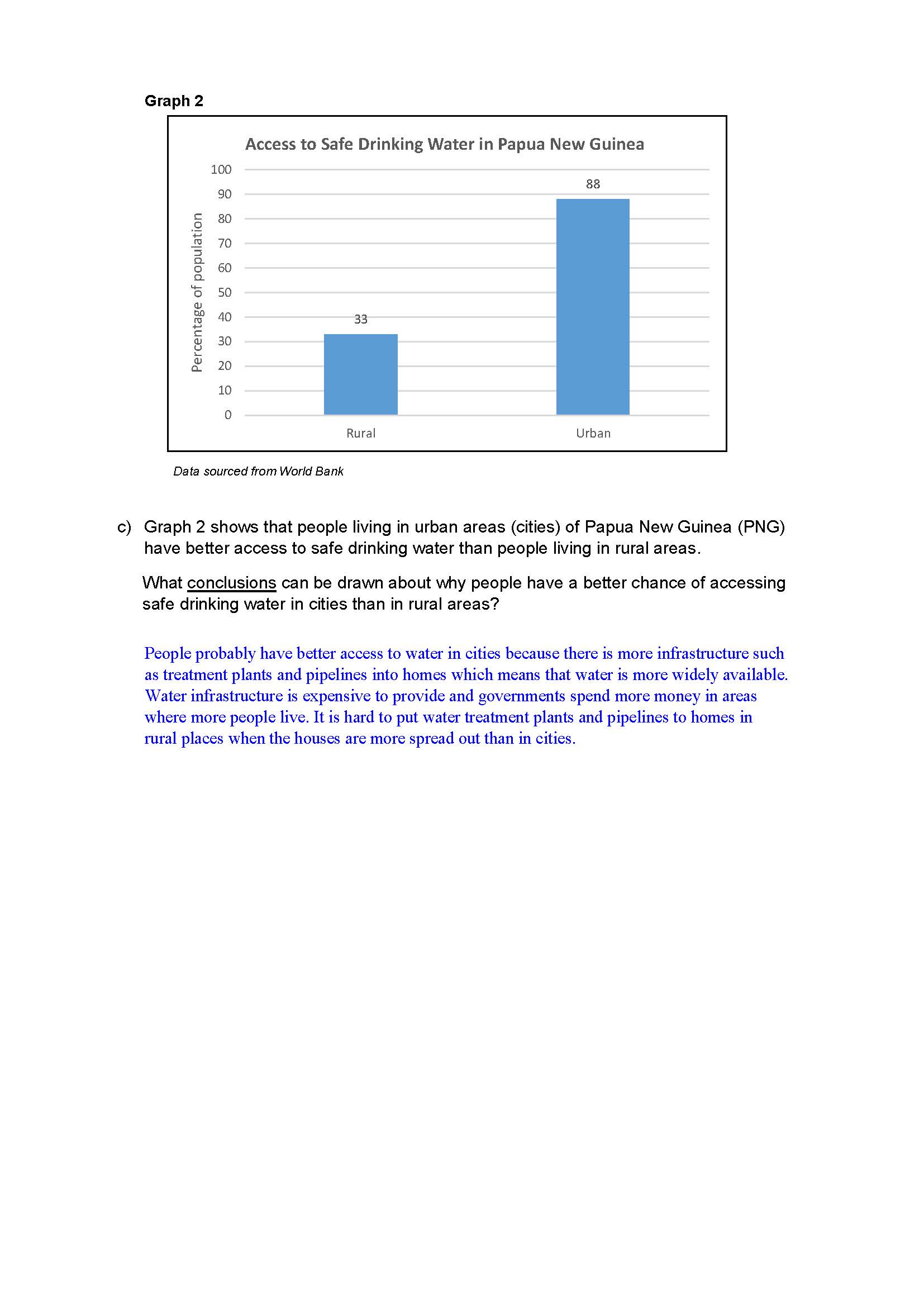 1
Learning Area
1
Learning Area
Uses relevant geographical terminology 2 Subject - Geography
Uses relevant geographical terminology 3 Learning Area
Draws a reasoned, detailed conclusion based on the data provided in the graph, using examples 4 Subject - Geography
Draws a reasoned, detailed conclusion based on the data provided in the graph, using examples
-
Annotations
-
1
Learning Area
Uses relevant geographical terminology -
2
Subject - Geography
Uses relevant geographical terminology -
3
Learning Area
Draws a reasoned, detailed conclusion based on the data provided in the graph, using examples -
4
Subject - Geography
Draws a reasoned, detailed conclusion based on the data provided in the graph, using examples
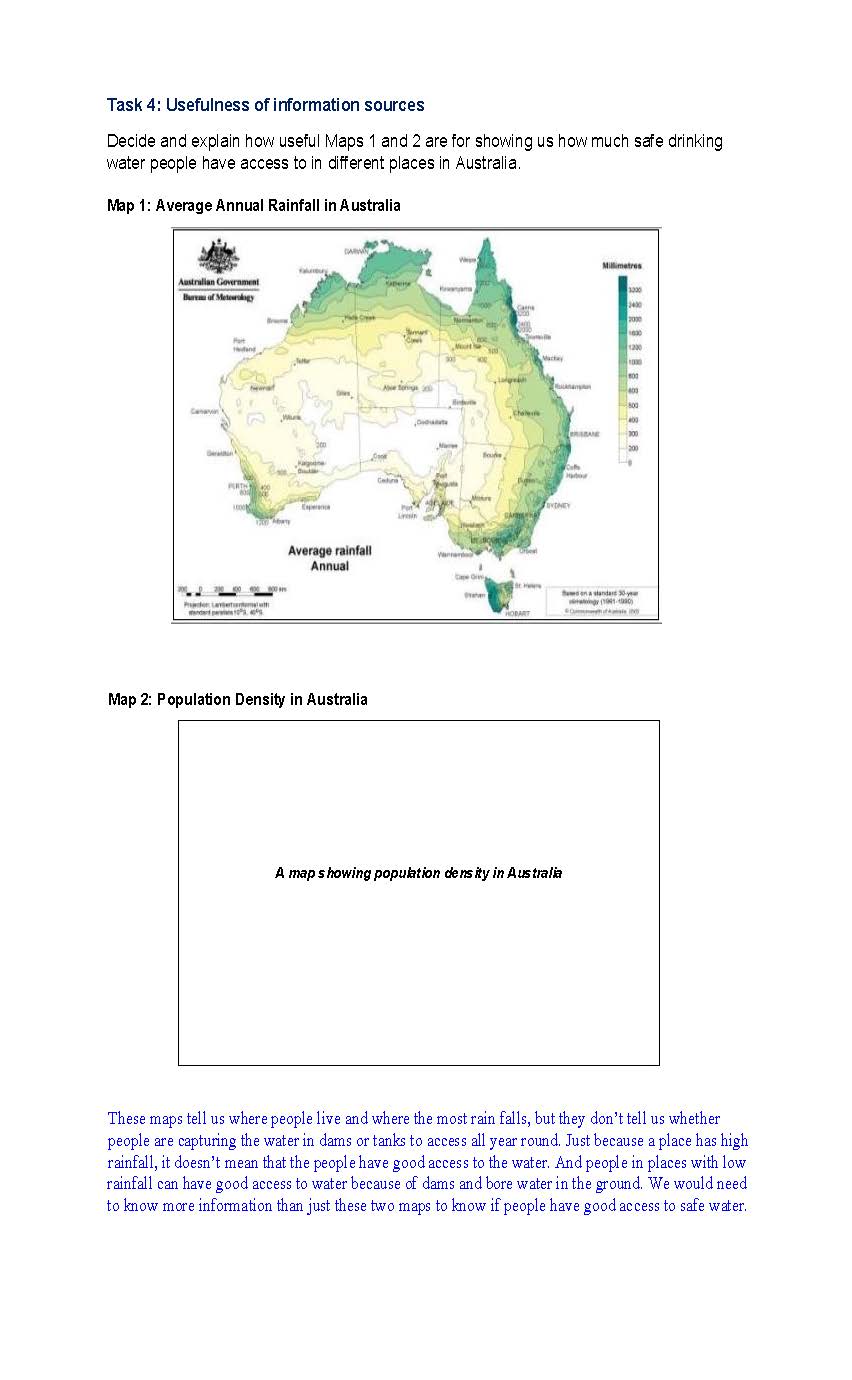 1
Learning Area
1
Learning Area
Identifies the purpose of different maps 2 Subject - Geography
Identifies the purpose of different maps 3 Learning Area
Justifies the need for more information by acknowledging each map’s limitations 4 Subject - Geography
Justifies the need for more information by acknowledging each map’s limitations 5 Learning Area
Uses both maps to explain in detail trends and relationships about rainfall and population 6 Subject - Geography
Uses both maps to explain in detail trends and relationships about rainfall and population
-
Annotations
-
1
Learning Area
Identifies the purpose of different maps -
2
Subject - Geography
Identifies the purpose of different maps -
3
Learning Area
Justifies the need for more information by acknowledging each map’s limitations -
4
Subject - Geography
Justifies the need for more information by acknowledging each map’s limitations -
5
Learning Area
Uses both maps to explain in detail trends and relationships about rainfall and population -
6
Subject - Geography
Uses both maps to explain in detail trends and relationships about rainfall and population
 1
Learning Area
1
Learning Area
Identifies strategies to address the challenge of water sustainability 2 Subject - Geography
Identifies strategies to address the challenge of water sustainability 3 Learning Area
Explains in detail the processes of water recycling and desalination 4 Subject - Geography
Explains in detail the processes of water recycling and desalination 5 Learning Area
Identifies possible positive and negative social and economic factors linked to recycled water and desalination 6 Subject - Geography
Identifies possible positive and negative social and economic factors linked to recycled water and desalination 7 Learning Area
Connects sustainable strategies for water to society and the environment 8 Subject - Geography
Connects sustainable strategies for water to society and the environment 9 Learning Area
Outlines positive and negative economic impacts associated with water recycling and desalination, using examples 10 Subject - Geography
Outlines positive and negative economic impacts associated with water recycling and desalination, using examples 11 Learning Area
Identifies and explains a connection between desalination, the economy and the environment 12 Subject - Geography
Identifies and explains a connection between desalination, the economy and the environment 13 Learning Area
Explains economic advantages and disadvantages of water recycling and desalination on society and the economy, using specific examples 14 Subject - Geography
Explains economic advantages and disadvantages of water recycling and desalination on society and the economy, using specific examples 15 Learning Area
Draws conclusions about the effects of water recycling and desalination 16 Subject - Geography
Draws conclusions about the effects of water recycling and desalination
-
Annotations
-
1
Learning Area
Identifies strategies to address the challenge of water sustainability -
2
Subject - Geography
Identifies strategies to address the challenge of water sustainability -
3
Learning Area
Explains in detail the processes of water recycling and desalination -
4
Subject - Geography
Explains in detail the processes of water recycling and desalination -
5
Learning Area
Identifies possible positive and negative social and economic factors linked to recycled water and desalination -
6
Subject - Geography
Identifies possible positive and negative social and economic factors linked to recycled water and desalination -
7
Learning Area
Connects sustainable strategies for water to society and the environment -
8
Subject - Geography
Connects sustainable strategies for water to society and the environment -
9
Learning Area
Outlines positive and negative economic impacts associated with water recycling and desalination, using examples -
10
Subject - Geography
Outlines positive and negative economic impacts associated with water recycling and desalination, using examples -
11
Learning Area
Identifies and explains a connection between desalination, the economy and the environment -
12
Subject - Geography
Identifies and explains a connection between desalination, the economy and the environment -
13
Learning Area
Explains economic advantages and disadvantages of water recycling and desalination on society and the economy, using specific examples -
14
Subject - Geography
Explains economic advantages and disadvantages of water recycling and desalination on society and the economy, using specific examples -
15
Learning Area
Draws conclusions about the effects of water recycling and desalination -
16
Subject - Geography
Draws conclusions about the effects of water recycling and desalination
Satisfactory
Data analysis: Water in the world
Annotations overview
Uses digital media and specific terms to communicate geographical processes
 1
Learning Area
1
Learning Area
Explains ways water connects people with different places and environments 2 Subject - Geography
Explains ways water connects people with different places and environments 3 Learning Area
Describes geographical processes 4 Subject - Geography
Describes geographical processes 5 Learning Area
Describes interconnections between people and water 6 Subject - Geography
Describes interconnections between people and water 7 Learning Area
Describes how people’s interconnections change places and environments 8 Subject - Geography
Describes how people’s interconnections change places and environments 9 Learning Area
Uses some geographical terminology 10 Subject - Geography
Uses some geographical terminology
-
Annotations
-
1
Learning Area
Explains ways water connects people with different places and environments -
2
Subject - Geography
Explains ways water connects people with different places and environments -
3
Learning Area
Describes geographical processes -
4
Subject - Geography
Describes geographical processes -
5
Learning Area
Describes interconnections between people and water -
6
Subject - Geography
Describes interconnections between people and water -
7
Learning Area
Describes how people’s interconnections change places and environments -
8
Subject - Geography
Describes how people’s interconnections change places and environments -
9
Learning Area
Uses some geographical terminology -
10
Subject - Geography
Uses some geographical terminology
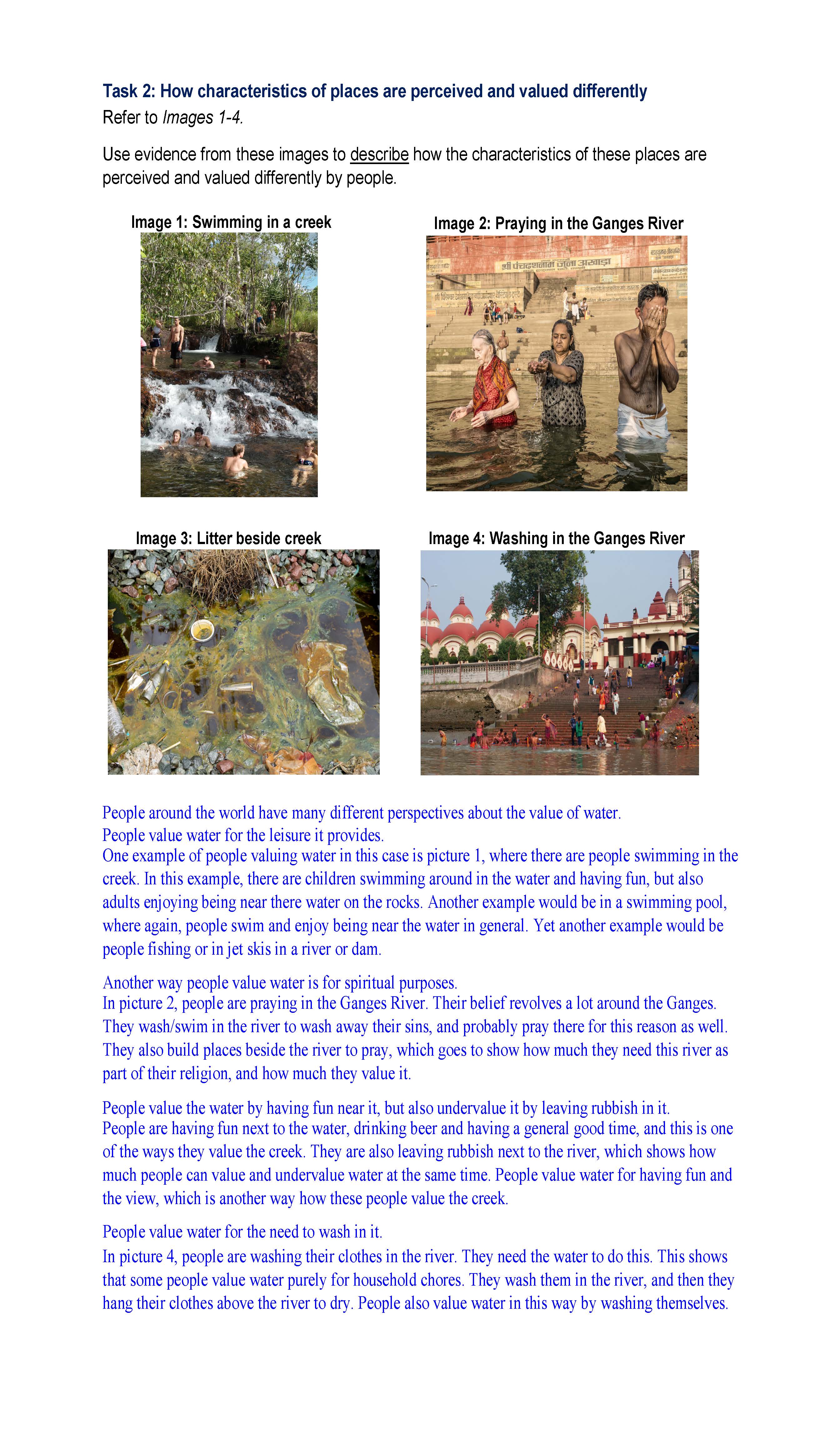 1
Learning Area
1
Learning Area
Presents arguments about a geographical phenomenon 2 Subject - Geography
Presents arguments about a geographical phenomenon 3 Learning Area
Presents arguments about a geographical phenomenon 4 Subject - Geography
Describes ways people engage with and value bodies of water 5 Learning Area
Analyses evidence in geographical images to draw conclusions 6 Subject - Geography
Analyses evidence in geographical images to draw conclusions 7 Learning Area
Describes positive as well as negative impacts people have on a body of water 8 Subject - Geography
Describes positive as well as negative impacts people have on a body of water
-
Annotations
-
1
Learning Area
Presents arguments about a geographical phenomenon -
2
Subject - Geography
Presents arguments about a geographical phenomenon -
3
Learning Area
Presents arguments about a geographical phenomenon -
4
Subject - Geography
Describes ways people engage with and value bodies of water -
5
Learning Area
Analyses evidence in geographical images to draw conclusions -
6
Subject - Geography
Analyses evidence in geographical images to draw conclusions -
7
Learning Area
Describes positive as well as negative impacts people have on a body of water -
8
Subject - Geography
Describes positive as well as negative impacts people have on a body of water
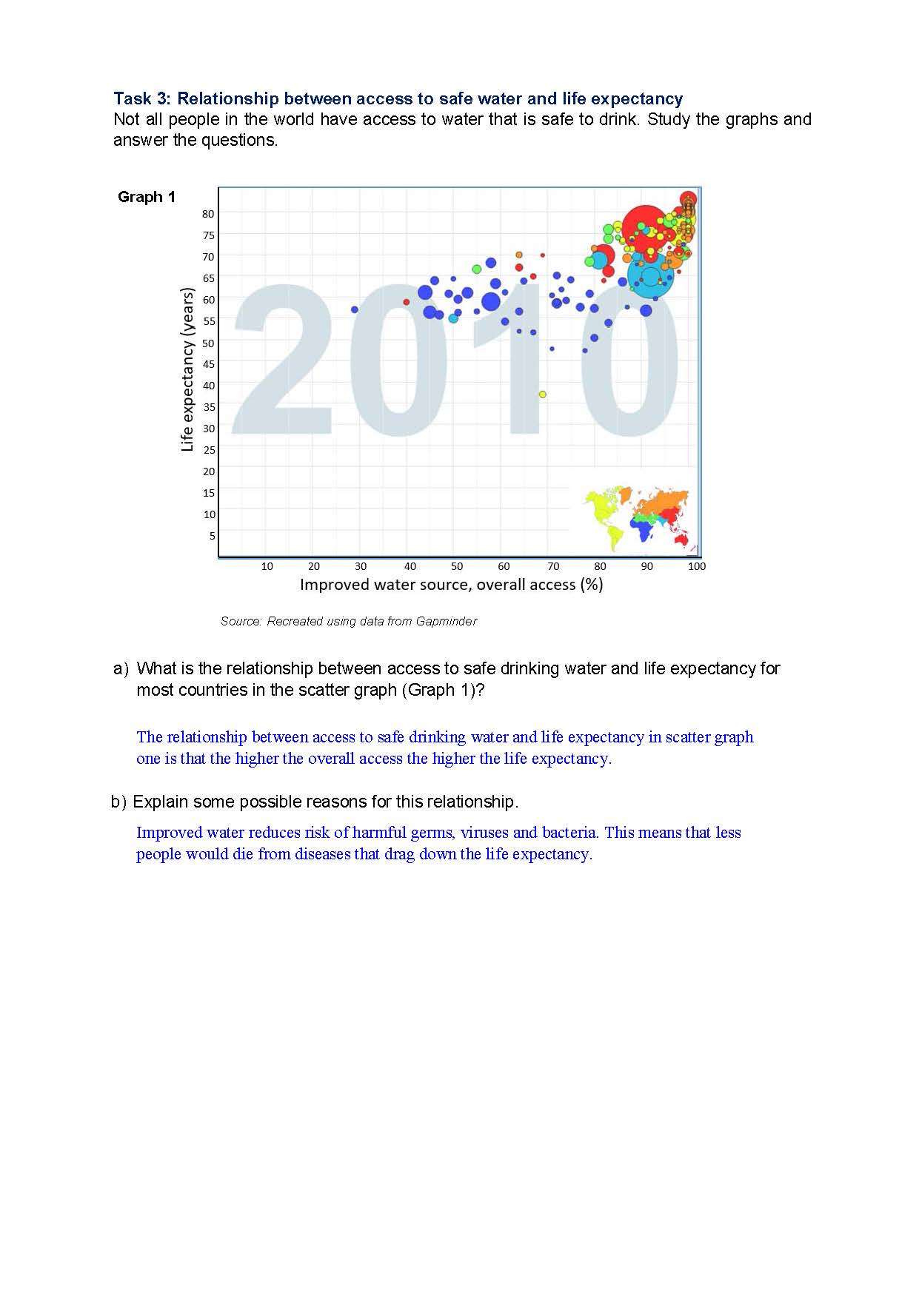 1
Learning Area
1
Learning Area
Identifies relationships between the variables, access to safe drinking water and life expectancy 2 Subject - Geography
Identifies relationships between the variables, access to safe drinking water and life expectancy 3 Learning Area
Accurately interprets graphic data to draw conclusions 4 Subject - Geography
Accurately interprets graphic data to draw conclusions 5 Learning Area
Explains how access to safe drinking water is connected to life expectancy 6 Subject - Geography
Explains how access to safe drinking water is connected to life expectancy
-
Annotations
-
1
Learning Area
Identifies relationships between the variables, access to safe drinking water and life expectancy -
2
Subject - Geography
Identifies relationships between the variables, access to safe drinking water and life expectancy -
3
Learning Area
Accurately interprets graphic data to draw conclusions -
4
Subject - Geography
Accurately interprets graphic data to draw conclusions -
5
Learning Area
Explains how access to safe drinking water is connected to life expectancy -
6
Subject - Geography
Explains how access to safe drinking water is connected to life expectancy
 1
Learning Area
1
Learning Area
Draws a reasoned conclusion based on the data provided in a graph, using an example 2 Subject - Geography
Draws a reasoned conclusion based on the data provided in a graph, using an example
-
Annotations
-
1
Learning Area
Draws a reasoned conclusion based on the data provided in a graph, using an example -
2
Subject - Geography
Draws a reasoned conclusion based on the data provided in a graph, using an example
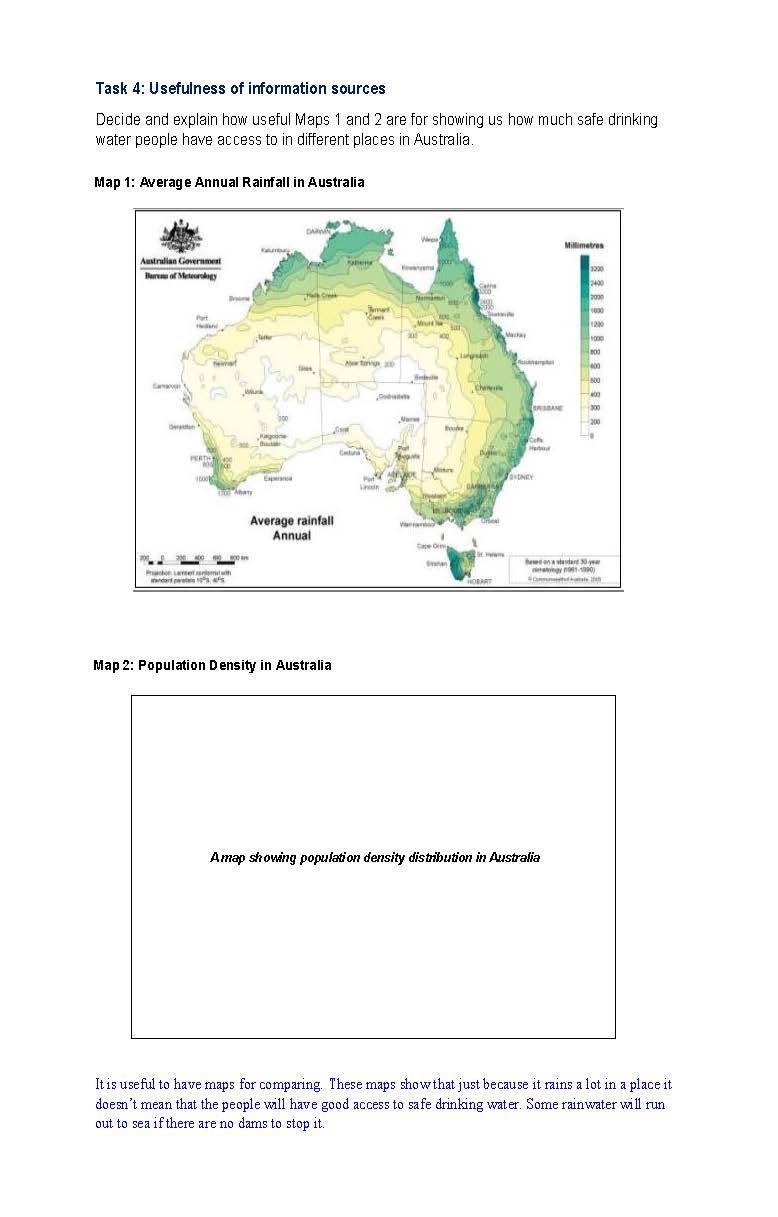 1
Learning Area
1
Learning Area
Describes the usefulness and relevance of more than one map to compare data 2 Subject - Geography
Describes the usefulness and relevance of more than one map to compare data 3 Learning Area
Interprets information from maps to draw conclusions about connections between rainfall and population 4 Subject - Geography
Interprets information from maps to draw conclusions about connections between rainfall and population
-
Annotations
-
1
Learning Area
Describes the usefulness and relevance of more than one map to compare data -
2
Subject - Geography
Describes the usefulness and relevance of more than one map to compare data -
3
Learning Area
Interprets information from maps to draw conclusions about connections between rainfall and population -
4
Subject - Geography
Interprets information from maps to draw conclusions about connections between rainfall and population
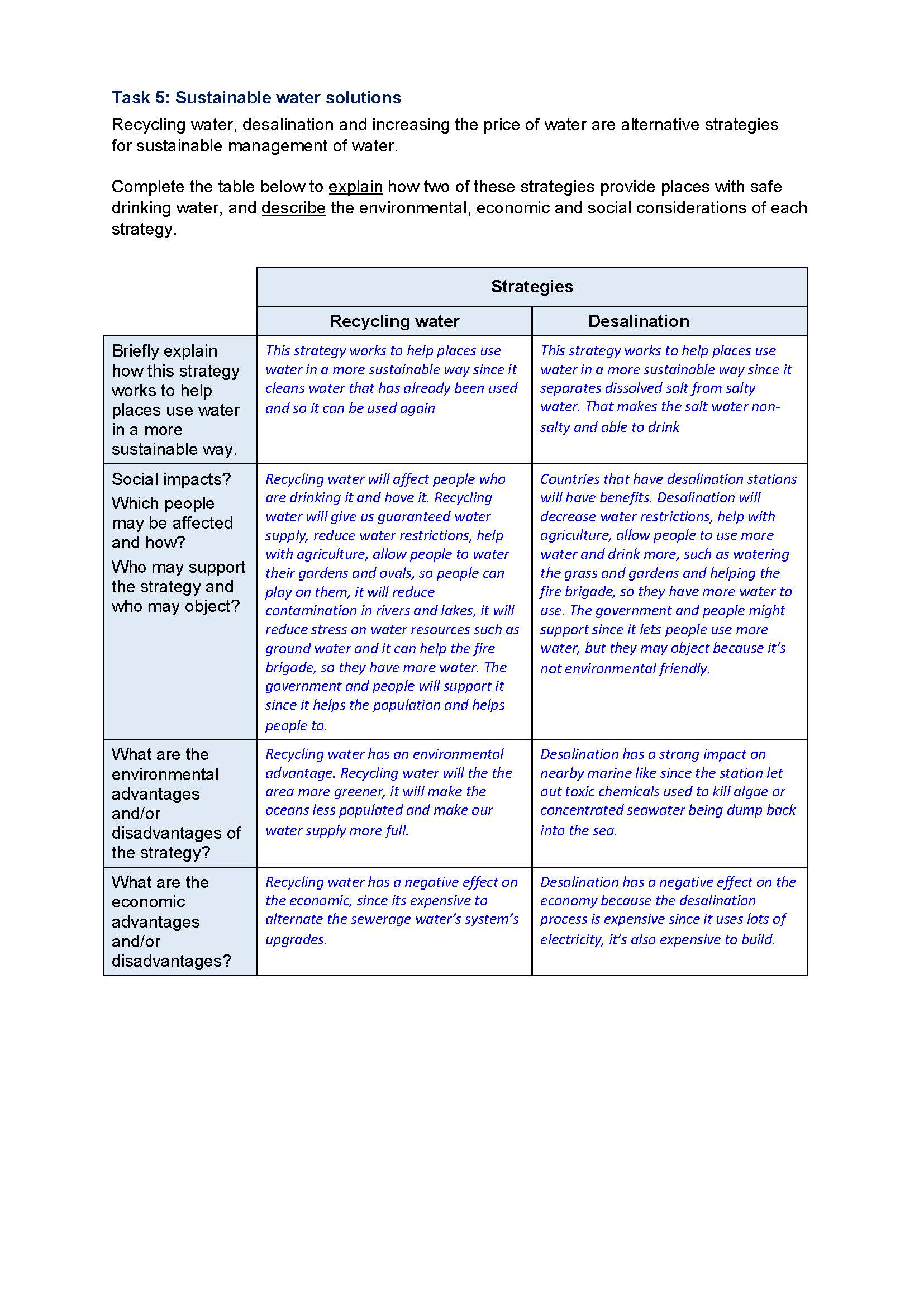 1
Learning Area
1
Learning Area
Identifies strategies to address the challenge of water sustainability 2 Subject - Geography
Identifies strategies to address the challenge of water sustainability 3 Learning Area
Explains the processes of water recycling and desalination with some details 4 Subject - Geography
Explains the processes of water recycling and desalination with some details 5 Learning Area
Makes a simple connection between the process of water recycling and sustainability 6 Subject - Geography
Makes a simple connection between the process of water recycling and sustainability 7 Learning Area
Identifies a range of social benefits and people associated with water recycling and desalination 8 Subject - Geography
Identifies a range of social benefits and people associated with water recycling and desalination 9 Learning Area
Identifies positive environmental impacts of water recycling and desalination 10 Subject - Geography
Identifies positive environmental impacts of water recycling and desalination 11 Learning Area
Identifies a connection between desalination and the environment 12 Subject - Geography
Identifies a connection between desalination and the environment 13 Learning Area
Identifies negative economic effects of water recycling and desalination 14 Subject - Geography
Identifies negative economic effects of water recycling and desalination 15 Learning Area
Uses relevant geographical terminology 16 Subject - Geography
Uses relevant geographical terminology
-
Annotations
-
1
Learning Area
Identifies strategies to address the challenge of water sustainability -
2
Subject - Geography
Identifies strategies to address the challenge of water sustainability -
3
Learning Area
Explains the processes of water recycling and desalination with some details -
4
Subject - Geography
Explains the processes of water recycling and desalination with some details -
5
Learning Area
Makes a simple connection between the process of water recycling and sustainability -
6
Subject - Geography
Makes a simple connection between the process of water recycling and sustainability -
7
Learning Area
Identifies a range of social benefits and people associated with water recycling and desalination -
8
Subject - Geography
Identifies a range of social benefits and people associated with water recycling and desalination -
9
Learning Area
Identifies positive environmental impacts of water recycling and desalination -
10
Subject - Geography
Identifies positive environmental impacts of water recycling and desalination -
11
Learning Area
Identifies a connection between desalination and the environment -
12
Subject - Geography
Identifies a connection between desalination and the environment -
13
Learning Area
Identifies negative economic effects of water recycling and desalination -
14
Subject - Geography
Identifies negative economic effects of water recycling and desalination -
15
Learning Area
Uses relevant geographical terminology -
16
Subject - Geography
Uses relevant geographical terminology
Above satisfactory
Data analysis: Water in the world
 1
Learning Area
1
Learning Area
Articulates the overall connection between water, people, places and environments 2 Subject - Geography
Articulates the overall connection between water, people, places and environments 3 Learning Area
Explains a connection between people’s use of water and its impact on the environment 4 Subject - Geography
Explains a connection between people’s use of water and its impact on the environment 5 Learning Area
Predicts a geographical outcome using a conceptual argument 6 Subject - Geography
Predicts a geographical outcome using a conceptual argument
-
Annotations
-
1
Learning Area
Articulates the overall connection between water, people, places and environments -
2
Subject - Geography
Articulates the overall connection between water, people, places and environments -
3
Learning Area
Explains a connection between people’s use of water and its impact on the environment -
4
Subject - Geography
Explains a connection between people’s use of water and its impact on the environment -
5
Learning Area
Predicts a geographical outcome using a conceptual argument -
6
Subject - Geography
Predicts a geographical outcome using a conceptual argument
 1
Learning Area
1
Learning Area
Provides a comprehensive description of how interconnections change places and environments 2 Subject - Geography
Provides a comprehensive description of how interconnections change places and environments 3 Learning Area
Uses relevant geographical terminology in an appropriate context 4 Subject - Geography
Uses relevant geographical terminology in an appropriate context 5 Learning Area
Draws conclusions using multiple connections from the diagram 6 Subject - Geography
Draws conclusions using multiple connections from the diagram 7 Learning Area
Describes in detail the interconnections between people’s actions and the environment 8 Subject - Geography
Describes in detail the interconnections between people’s actions and the environment
-
Annotations
-
1
Learning Area
Provides a comprehensive description of how interconnections change places and environments -
2
Subject - Geography
Provides a comprehensive description of how interconnections change places and environments -
3
Learning Area
Uses relevant geographical terminology in an appropriate context -
4
Subject - Geography
Uses relevant geographical terminology in an appropriate context -
5
Learning Area
Draws conclusions using multiple connections from the diagram -
6
Subject - Geography
Draws conclusions using multiple connections from the diagram -
7
Learning Area
Describes in detail the interconnections between people’s actions and the environment -
8
Subject - Geography
Describes in detail the interconnections between people’s actions and the environment
 1
Learning Area
1
Learning Area
Presents an argument about a geographical phenomenon 2 Subject - Geography
Presents an argument about a geographical phenomenon 3 Learning Area
Describes a reason why people may perceive and value water differently 4 Subject - Geography
Describes a reason why people may perceive and value water differently 5 Learning Area
Explains the challenges associated with multiple uses of a single body of water 6 Subject - Geography
Explains the challenges associated with multiple uses of a single body of water 7 Learning Area
Proposes an explanation for negative use of water 8 Subject - Geography
Proposes an explanation for negative use of water 9 Learning Area
Synthesises evidence from multiple sources 10 Subject - Geography
Synthesises evidence from multiple sources 11 Learning Area
Draws a conclusion about how people view water differently 12 Subject - Geography
Draws a conclusion about how people view water differently
-
Annotations
-
1
Learning Area
Presents an argument about a geographical phenomenon -
2
Subject - Geography
Presents an argument about a geographical phenomenon -
3
Learning Area
Describes a reason why people may perceive and value water differently -
4
Subject - Geography
Describes a reason why people may perceive and value water differently -
5
Learning Area
Explains the challenges associated with multiple uses of a single body of water -
6
Subject - Geography
Explains the challenges associated with multiple uses of a single body of water -
7
Learning Area
Proposes an explanation for negative use of water -
8
Subject - Geography
Proposes an explanation for negative use of water -
9
Learning Area
Synthesises evidence from multiple sources -
10
Subject - Geography
Synthesises evidence from multiple sources -
11
Learning Area
Draws a conclusion about how people view water differently -
12
Subject - Geography
Draws a conclusion about how people view water differently
 1
Learning Area
1
Learning Area
Describes accurately a geographic trend, citing specific data from the graph 2 Subject - Geography
Describes accurately a geographic trend, citing specific data from the graph 3 Learning Area
Identifies relationships between variables 4 Subject - Geography
Identifies relationships between variables 5 Learning Area
Uses relevant geographical terminology 6 Subject - Geography
Uses relevant geographical terminology 7 Learning Area
Synthesises data to draw a detailed conclusion 8 Subject - Geography
Synthesises data to draw a detailed conclusion 9 Learning Area
Explains how access to safe drinking water is connected to life expectancy, citing examples from the graph 10 Subject - Geography
Explains how access to safe drinking water is connected to life expectancy, citing examples from the graph
-
Annotations
-
1
Learning Area
Describes accurately a geographic trend, citing specific data from the graph -
2
Subject - Geography
Describes accurately a geographic trend, citing specific data from the graph -
3
Learning Area
Identifies relationships between variables -
4
Subject - Geography
Identifies relationships between variables -
5
Learning Area
Uses relevant geographical terminology -
6
Subject - Geography
Uses relevant geographical terminology -
7
Learning Area
Synthesises data to draw a detailed conclusion -
8
Subject - Geography
Synthesises data to draw a detailed conclusion -
9
Learning Area
Explains how access to safe drinking water is connected to life expectancy, citing examples from the graph -
10
Subject - Geography
Explains how access to safe drinking water is connected to life expectancy, citing examples from the graph
 1
Learning Area
1
Learning Area
Uses relevant geographical terminology 2 Subject - Geography
Uses relevant geographical terminology 3 Learning Area
Draws a reasoned, detailed conclusion based on the data provided in the graph, using examples 4 Subject - Geography
Draws a reasoned, detailed conclusion based on the data provided in the graph, using examples
-
Annotations
-
1
Learning Area
Uses relevant geographical terminology -
2
Subject - Geography
Uses relevant geographical terminology -
3
Learning Area
Draws a reasoned, detailed conclusion based on the data provided in the graph, using examples -
4
Subject - Geography
Draws a reasoned, detailed conclusion based on the data provided in the graph, using examples
 1
Learning Area
1
Learning Area
Identifies the purpose of different maps 2 Subject - Geography
Identifies the purpose of different maps 3 Learning Area
Justifies the need for more information by acknowledging each map’s limitations 4 Subject - Geography
Justifies the need for more information by acknowledging each map’s limitations 5 Learning Area
Uses both maps to explain in detail trends and relationships about rainfall and population 6 Subject - Geography
Uses both maps to explain in detail trends and relationships about rainfall and population
-
Annotations
-
1
Learning Area
Identifies the purpose of different maps -
2
Subject - Geography
Identifies the purpose of different maps -
3
Learning Area
Justifies the need for more information by acknowledging each map’s limitations -
4
Subject - Geography
Justifies the need for more information by acknowledging each map’s limitations -
5
Learning Area
Uses both maps to explain in detail trends and relationships about rainfall and population -
6
Subject - Geography
Uses both maps to explain in detail trends and relationships about rainfall and population
 1
Learning Area
1
Learning Area
Identifies strategies to address the challenge of water sustainability 2 Subject - Geography
Identifies strategies to address the challenge of water sustainability 3 Learning Area
Explains in detail the processes of water recycling and desalination 4 Subject - Geography
Explains in detail the processes of water recycling and desalination 5 Learning Area
Identifies possible positive and negative social and economic factors linked to recycled water and desalination 6 Subject - Geography
Identifies possible positive and negative social and economic factors linked to recycled water and desalination 7 Learning Area
Connects sustainable strategies for water to society and the environment 8 Subject - Geography
Connects sustainable strategies for water to society and the environment 9 Learning Area
Outlines positive and negative economic impacts associated with water recycling and desalination, using examples 10 Subject - Geography
Outlines positive and negative economic impacts associated with water recycling and desalination, using examples 11 Learning Area
Identifies and explains a connection between desalination, the economy and the environment 12 Subject - Geography
Identifies and explains a connection between desalination, the economy and the environment 13 Learning Area
Explains economic advantages and disadvantages of water recycling and desalination on society and the economy, using specific examples 14 Subject - Geography
Explains economic advantages and disadvantages of water recycling and desalination on society and the economy, using specific examples 15 Learning Area
Draws conclusions about the effects of water recycling and desalination 16 Subject - Geography
Draws conclusions about the effects of water recycling and desalination
-
Annotations
-
1
Learning Area
Identifies strategies to address the challenge of water sustainability -
2
Subject - Geography
Identifies strategies to address the challenge of water sustainability -
3
Learning Area
Explains in detail the processes of water recycling and desalination -
4
Subject - Geography
Explains in detail the processes of water recycling and desalination -
5
Learning Area
Identifies possible positive and negative social and economic factors linked to recycled water and desalination -
6
Subject - Geography
Identifies possible positive and negative social and economic factors linked to recycled water and desalination -
7
Learning Area
Connects sustainable strategies for water to society and the environment -
8
Subject - Geography
Connects sustainable strategies for water to society and the environment -
9
Learning Area
Outlines positive and negative economic impacts associated with water recycling and desalination, using examples -
10
Subject - Geography
Outlines positive and negative economic impacts associated with water recycling and desalination, using examples -
11
Learning Area
Identifies and explains a connection between desalination, the economy and the environment -
12
Subject - Geography
Identifies and explains a connection between desalination, the economy and the environment -
13
Learning Area
Explains economic advantages and disadvantages of water recycling and desalination on society and the economy, using specific examples -
14
Subject - Geography
Explains economic advantages and disadvantages of water recycling and desalination on society and the economy, using specific examples -
15
Learning Area
Draws conclusions about the effects of water recycling and desalination -
16
Subject - Geography
Draws conclusions about the effects of water recycling and desalination